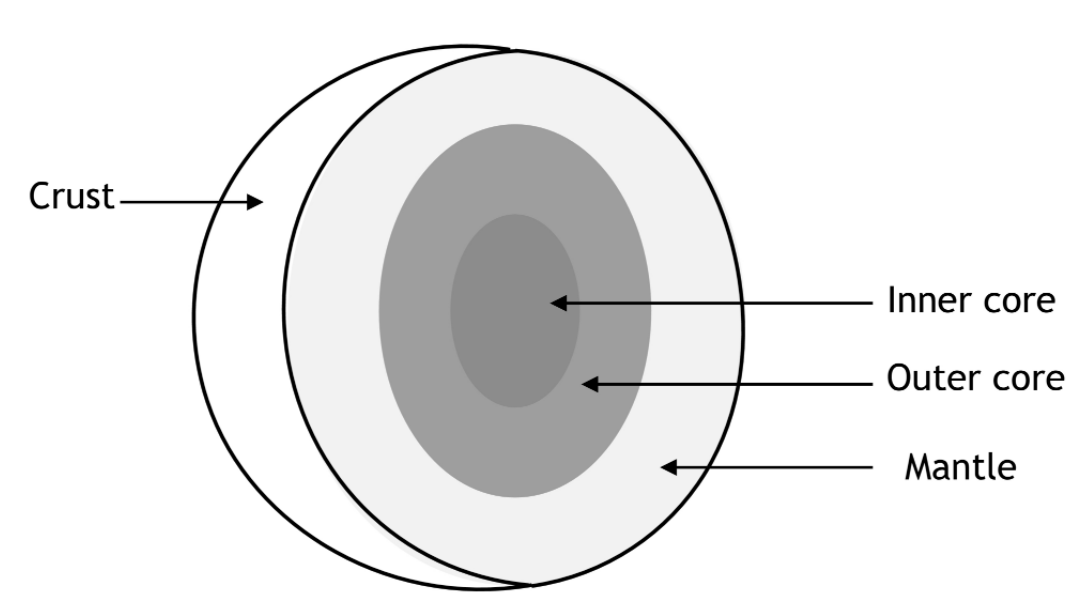
The Central and the Hottest part of Earth is called
(A) Inner Core
(B) Outer Core
(C) Crust
(D) Mantle
Answer
484.8k+ views
Hint: In order to solve this question we need to understand that if we subdivide the Earth based on rheology, we see the lithosphere, asthenosphere, mesosphere, outer core, and inner core. However, if we differentiate the layers based on chemical variations, we lump the layers into the crust, mantle, outer core, and inner core.
Complete step by step answer:
The Earth is made up of four major layers: the crust, the mantle, the outer core, and the inner core. The crust is the thinnest portion, while the mantle is the thickest. The structure of the earth can be shown in the below image.

The liquid outer core separates the inner core from the rest of the Earth, and as a result, the inner core rotates a little differently than the rest of the planet.
It is the centre and the hottest layer of the Earth. The inner core is solid and made up of iron and nickel with temperature up to $ 5,{500^ \circ }C. $ Due to its immense heat energy, the inner core is more like the engine room of the Earth. Inner core is made basically out of iron and nickel and has a sweep of approximately 1,220 km. Thickness in the core ranges between $ 12,600 - 13,000{\text{ Kg/}}{{\text{m}}^3}. $
$ \therefore$ The Central and the Hottest part of Earth is called the Inner core.
Note:
It should be remembered that the thin parts of the crust are also called the oceanic crust and the thicker crust is called the continental crust. The thicker crust will be less dense compared to that of the thin crust parts. The mantle has no subparts. The temperature of the inner core is far above the melting point of iron. However, unlike the outer core, the inner core is not liquid or even molten. The outer core is a liquid mix of iron and nickel, but the inner core is solid metal.
Complete step by step answer:
The Earth is made up of four major layers: the crust, the mantle, the outer core, and the inner core. The crust is the thinnest portion, while the mantle is the thickest. The structure of the earth can be shown in the below image.

The liquid outer core separates the inner core from the rest of the Earth, and as a result, the inner core rotates a little differently than the rest of the planet.
It is the centre and the hottest layer of the Earth. The inner core is solid and made up of iron and nickel with temperature up to $ 5,{500^ \circ }C. $ Due to its immense heat energy, the inner core is more like the engine room of the Earth. Inner core is made basically out of iron and nickel and has a sweep of approximately 1,220 km. Thickness in the core ranges between $ 12,600 - 13,000{\text{ Kg/}}{{\text{m}}^3}. $
$ \therefore$ The Central and the Hottest part of Earth is called the Inner core.
Note:
It should be remembered that the thin parts of the crust are also called the oceanic crust and the thicker crust is called the continental crust. The thicker crust will be less dense compared to that of the thin crust parts. The mantle has no subparts. The temperature of the inner core is far above the melting point of iron. However, unlike the outer core, the inner core is not liquid or even molten. The outer core is a liquid mix of iron and nickel, but the inner core is solid metal.
Recently Updated Pages
Master Class 11 Economics: Engaging Questions & Answers for Success

Master Class 11 English: Engaging Questions & Answers for Success

Master Class 11 Social Science: Engaging Questions & Answers for Success

Master Class 11 Biology: Engaging Questions & Answers for Success

Class 11 Question and Answer - Your Ultimate Solutions Guide

Master Class 11 Business Studies: Engaging Questions & Answers for Success

Trending doubts
1 Quintal is equal to a 110 kg b 10 kg c 100kg d 1000 class 11 physics CBSE

What is a periderm How does periderm formation take class 11 biology CBSE

What are porins class 11 biology CBSE

Why is steel more elastic than rubber class 11 physics CBSE

Differentiate between red algae and brown algae class 11 biology CBSE

What is boron A Nonmetal B Metal C Metalloid D All class 11 chemistry CBSE




